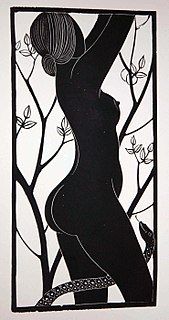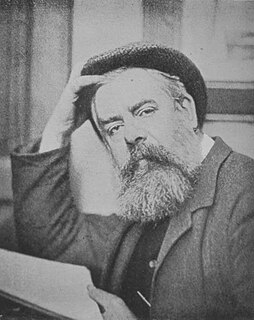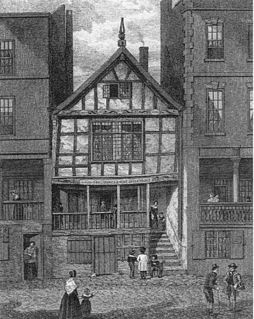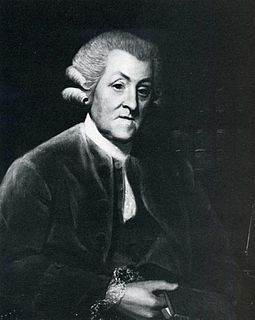
John Burnet was a Scottish engraver and painter.

Eric William Ravilious was a British painter, designer, book illustrator and wood-engraver. He grew up in Sussex, and is particularly known for his watercolours of the South Downs and other English landscapes, which examine English landscape and vernacular art with an off-kilter, modernist sensibility and clarity. He served as a war artist, and died when the aircraft he was in was lost off Iceland.

The Society of Wood Engravers (SWE) is a UK-based artists’ exhibiting society, formed in 1920, one of its founder-members being Eric Gill. It was originally restricted to artist-engravers printing with oil-based inks in a press, distinct from the separate discipline of woodcuts. Today, its support extends to other forms of relief printmaking, and awards honorary membership to collectors and enthusiasts.

Robert Smirke was an English painter and illustrator, specialising in small paintings showing subjects taken from literature. He was a member of the Royal Academy.

Sir Hubert von Herkomer was a Bavarian-born British painter, pioneering film-director, and composer. Though a very successful portrait artist, especially of men, he is mainly remembered for his earlier works that took a realistic approach to the conditions of life of the poor. Hard Times showing the distraught family of a travelling day-labourer at the side of a road, is one of his best-known works.

John Raphael Smith was a British painter and mezzotinter. He was the son of Thomas Smith of Derby, the landscape painter, and father of John Rubens Smith, a painter who emigrated to the United States.

Francis Barlow was an English painter, etcher, and illustrator.

Sir Leslie Matthew Ward was a British portrait artist and caricaturist who over four decades painted 1,325 portraits which were regularly published by Vanity Fair, under the pseudonyms "Spy" and "Drawl". The portraits were produced as watercolours and turned into chromolithographs for publication in the magazine. These were then usually reproduced on better paper and sold as prints. Such was his influence in the genre that all Vanity Fair caricatures are sometimes referred to as "Spy cartoons" regardless of who the artist actually was.

Martin Droeshout was an English engraver of Flemish descent, who is best known as illustrator of the title portrait for William Shakespeare's collected works, the First Folio of 1623, edited by John Heminges and Henry Condell, fellow actors of the Bard. Nevertheless, Droeshout produced other more ambitious designs in his career.
Gertrude Anna Bertha Hermes was a British wood-engraver and sculptor. Hermes was a member of the English Wood Engraving Society (1925–31) and exhibited with the Society of Wood Engravers, the Royal Academy and The London Group during the 1930s.

Frederick Hollyer was an English photographer and engraver known for his photographic reproductions of paintings and drawings, particularly those of the Pre-Raphaelite Brotherhood, and for portraits of literary and artistic figures of late Victorian and Edwardian London.

John Romney was an English artist in printmaking and watercolour who lived and worked in London and Chester. Much of his work consisted of reproductions of the work of other artists, but he produced some original prints, paintings and drawings. Like the great majority of contemporary printmakers he worked in both engraving and etching, often on the same plate, and descriptions of his prints as being in one or the other technique should be taken loosely. His best known original prints are series of views of the Chester area and his part of one on the antiquities in the British Museum. He was apparently not related to the famous portraitist George Romney (1734–1802).

Samuel William Reynolds was a mezzotint engraver, landscape painter and landscape gardener. Reynolds was a popular engraver in both Britain and France and there are over 400 examples of his work in the National Portrait Gallery, London.
William Henry Mote (1803–1871) was a British stipple and line engraver, primarily known for his portraits. He produced etchings for reference books, as well as original etchings. Mote became a member of the Royal Academy in his twenties and his portraits hang in the National Portrait Gallery, London.

Edward Scriven was an English engraver of portraits, in the stipple and chalk manner. Scriven was the pre-eminent engraver of his generation, with 210 portraits ascribed to him by the National Portrait Gallery.

Emily Sartain was an American painter and engraver. She was the first woman in Europe and the United States to practice the art of mezzotint engraving, and the only woman to win a gold medal at the 1876 World Fair in Philadelphia. Sartain became a nationally recognized art educator and was the director of the Philadelphia School of Design for Women from 1866 to 1920. Her father, John Sartain, and three of her brothers, William, Henry and Samuel were artists. Before she entered the Pennsylvania Academy of the Fine Arts and studied abroad, her father took her on a Grand Tour of Europe. She helped found the New Century Club for working and professional women, and the professional women's art clubs, The Plastic Club and The Three Arts Club.

Peter Mazell was an Irish painter and engraver, working in London between c. 1761 and 1797. He is known for his fine engravings of natural history subjects, especially those illustrating books by John Walcott and the Welsh naturalist Thomas Pennant. He created almost 600 engravings in his career. He also exhibited paintings of landscapes and of flowers. He exhibited at the Society of Artists and at the Royal Academy.

James Roberts (1753–ca.1809) was a painter active in England in the later 18th century. He is best known as a portraitist, though he also painted landscapes and miniatures.

Edward Orme (1775-1848) was a British engraver, painter and publisher of illustrated books. He was also a property developer in Bayswater, where Orme Square was named after him.

Horace Downey Harral was a British wood-engraver, etcher and photographer. He was a pupil of John Orrin Smith and later joined him as a partner in an engraving firm. Harral produced prints of many Pre-Raphaelite paintings and also illustrated many British periodicals of the mid-Victorian era. He engraved Robert Howlett's photograph Isambard Kingdom Brunel Standing Before the Launching Chains of the Great Eastern, one of the most famous and finest of the 19th century, for publication in the Illustrated Times in 1858. Harral also produced etchings and photographs. He is noted for an 1860s series of theatrically posed photographs of his friends. Harral once shared an office with William Luson Thomas and was later a significant shareholder in his company, which published The Graphic newspaper. Harral died a wealthy man and left the bulk of his estate to charity.


















